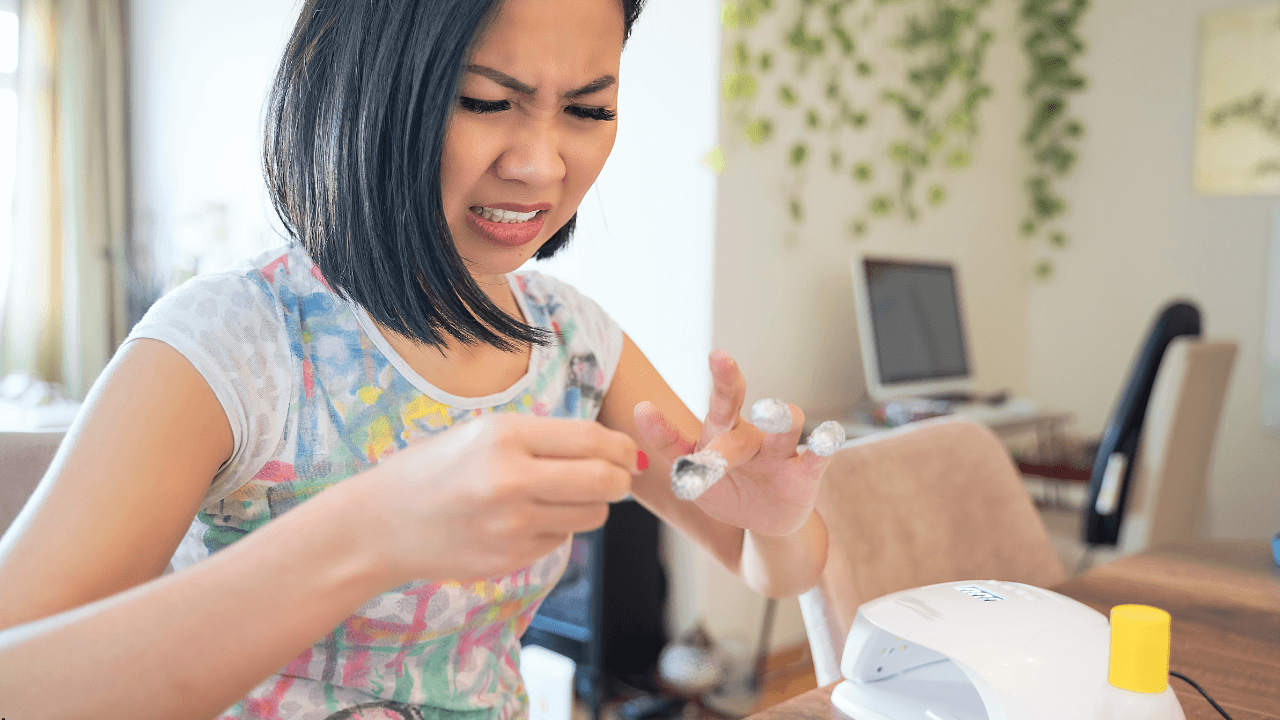How to Protect Nails from Damage Caused by Frequent Polish Use

For Distributors & Wholesalers
We welcome partnerships with distributors and wholesalers who wish to expand their business with a trusted and growing cosmetic brand.
Why Partner with Avlon International?
- Wide range of cosmetics: Nail polish, mascara, kajal, eyeliner, liquid lipstick, lipstick & more.
- Premium quality with competitive wholesale pricing.
- Attractive margins and fast-moving products.
- Assured support with marketing materials & promotional offers.
- PAN India shipping with secure packaging.
📦 Minimum Order Quantity (MOQ): 1 master carton (72 trays)
💰 Special Discounts: Available for bulk & long-term partners.
🚚 Dispatch & Delivery: PAN India in around 10-15 days.
📞 Contact Us:
Phone / WhatsApp: +91 88105 67775
Email: contactus@avloninternational.com
Website: www.avloninternational.com
Nail polish can be a fun and stylish way to express yourself, but frequent use can lead to damage if your nails aren’t properly cared for. Over time, constant application of polish, particularly harsh formulas or improper removal techniques, can cause nails to become dry, brittle, and discolored. However, with the right care routine, you can enjoy beautiful, polished nails without sacrificing their health.
In this comprehensive guide, we will explore how to protect your nails from damage caused by frequent polish use. From proper nail care techniques to choosing the right products, we’ll cover everything you need to maintain strong, healthy nails while still enjoying your favorite manicures.
You may also like:
The Effects of Frequent Nail Polish Use
Before diving into solutions, it’s important to understand the potential damage frequent nail polish use can cause:
- Dryness and Brittleness: Continuous polish application can dry out your nails and the surrounding cuticles, leading to breakage and peeling.
- Yellowing and Discoloration: Prolonged use of dark or highly pigmented nail polishes can stain your nails, causing them to appear yellow or discolored.
- Weakening: The chemicals in some nail polishes and removers (especially those containing acetone) can weaken the nail plate, making it more prone to splitting and breaking.
- Infection Risks: When nails are weak and damaged, they are more susceptible to fungal infections.
Now, let’s look at how you can prevent and minimize these effects while still enjoying your manicure.
1. Give Your Nails a Break
One of the simplest ways to protect your nails from damage is to give them a break from polish every now and then. Continuous nail polish use can suffocate your nails, preventing them from breathing and replenishing natural moisture. Taking a break between manicures allows your nails to recover and regain their strength.
- Recommendation: Give your nails at least one week of polish-free time every 2-3 weeks. This will help prevent over-drying and weakening.
2. Use a Nail Strengthener
If you love wearing nail polish regularly, incorporating a nail strengthener into your routine is essential. Nail strengtheners contain ingredients like keratin, biotin, and calcium that help fortify your nails, making them less prone to breakage and peeling. Some nail strengtheners can be used as a base coat, so they provide protection while you’re wearing polish.
- Key Ingredients to Look For:
- Keratin: The protein that makes up your nails, helping to strengthen and protect them.
- Biotin: A vitamin known to promote nail health and reduce brittleness.
- Calcium: Helps to reinforce the nail structure and prevent breakage.
- Vitamin E: Moisturizes and hydrates the nail plate.
- Recommendation: Apply a nail strengthener at least once or twice a week, especially during your polish-free days.
3. Apply a Base Coat
Never skip the base coat! Applying a base coat before nail polish not only extends the life of your manicure but also creates a protective barrier between your nails and the harsh chemicals found in nail polish. A base coat can also help prevent discoloration, especially when using dark-colored polishes.
- Why Use a Base Coat?:
- Prevents staining: Especially with red, blue, or dark shades.
- Strengthens nails: Many base coats are infused with strengthening ingredients.
- Improves polish adhesion: Keeps your polish intact for longer without chipping.
- Recommendation: Always use a high-quality base coat before applying nail polish. Some base coats are specifically designed to address different nail concerns like dryness, peeling, or weakness.
4. Opt for Non-Toxic, 10-Free Nail Polishes
Traditional nail polishes often contain harmful chemicals that can cause long-term damage to your nails. To protect your nails from chemical exposure, choose non-toxic, “10-free” or “5-free” nail polishes. These polishes are formulated without harmful ingredients such as formaldehyde, toluene, dibutyl phthalate (DBP), and other toxic chemicals that can weaken your nails over time.
- Top Ingredients to Avoid in Nail Polish:
- Formaldehyde: A carcinogen used to harden nail polish, which can also weaken your nails.
- Toluene: Can cause respiratory issues and skin irritation.
- Dibutyl Phthalate (DBP): Linked to hormone disruption.
- Camphor: Can cause yellowing of nails and irritate the skin.
- Recommendation: Opt for polishes that are labeled as “5-free,” “7-free,” or “10-free” to reduce exposure to these harsh chemicals. Brands like Zoya, Ella+Mila, and Deborah Lippmann offer excellent non-toxic options.
5. Be Gentle with Nail Polish Remover
Nail polish remover, especially acetone-based formulas, can be extremely drying to your nails and cuticles. Acetone strips the natural oils from your nails, leaving them dry, brittle, and prone to damage. Whenever possible, opt for non-acetone nail polish removers, which are gentler on the nails and skin.
- Why Choose Non-Acetone Removers?
- Gentler on nails: Non-acetone removers dry less.
- Safe for natural nails: They won’t strip essential moisture.
- Better for cuticles: Helps keep your cuticles hydrated.
- Recommendation: Use non-acetone polish removers, and limit your use of harsh removers to once a week. Avoid scraping or peeling off polish, as this can damage the nail surface.
6. Hydrate and Moisturize Regularly
Just like your skin, your nails need moisture to stay healthy. Dry nails are more likely to break, peel, and split. Frequent nail polish use can cause your nails and cuticles to lose moisture, leading to dryness and brittleness. To prevent this, make sure you’re moisturizing your nails and cuticles regularly.
- Key Products for Nail Hydration:
- Cuticle Oil: Helps nourish the cuticles and surrounding skin, promoting nail growth and preventing dryness.
- Hand Cream: Keeps both your hands and nails hydrated.
- Nail Serums: Targeted treatments that deliver hydration directly to the nail plate.
- Recommendation: Apply cuticle oil at least once daily, especially after washing your hands or removing nail polish. Follow up with a rich hand cream to lock in moisture.
7. Avoid Over-Buffing Your Nails
Buffing your nails too often or too aggressively can weaken them, making them more susceptible to breakage. While buffing helps smooth the nail surface and add shine, overdoing it can thin out your nails, causing them to become weak and brittle.
- Why Avoid Over-Buffing?:
- Weakens nails: Thins the nail plate, making it prone to damage.
- Reduces natural strength: Excessive buffing strips away the natural protective layers of the nail.
- Recommendation: Buff your nails no more than once a month, and use a gentle buffing block to avoid over-thinning the nails.
8. Trim and File Regularly
Keeping your nails at a manageable length can prevent them from breaking or splitting, especially if you use nail polish frequently. Regular trimming and filing help maintain the strength of your nails, allowing them to grow without becoming weak or brittle.
- How to Trim and File Properly:
- Trim nails when they’re soft: After a shower or bath is the best time.
- File in one direction: Avoid sawing back and forth, as this can weaken your nails.
- Use a fine-grit nail file: For smooth edges and reduced splitting.
- Recommendation: Keep your nails trimmed to your desired length and file them regularly to maintain strength and shape. Always use a high-quality nail file to avoid splitting.
9. Protect Your Nails During Everyday Tasks
Everyday tasks like washing dishes, cleaning, and typing can contribute to nail damage, especially if you’re wearing nail polish frequently. Harsh chemicals in cleaning products, exposure to water, and constant typing can weaken nails, making them more prone to breaking.
- Tips to Protect Your Nails:
- Wear gloves: Use rubber gloves when doing household chores or working with water.
- Avoid using your nails as tools: Don’t use your nails to open cans or packages, as this can cause them to chip or break.
- Limit water exposure: Prolonged exposure to water can soften your nails and make them more vulnerable to damage.
- Recommendation: Protect your nails by wearing gloves during chores and being mindful of how you use them during daily tasks.
10. Incorporate a Healthy Diet for Strong Nails
A healthy diet plays a significant role in the strength and appearance of your nails. Nutrient deficiencies can contribute to weak, brittle nails, so it’s important to maintain a balanced diet rich in vitamins and minerals that support nail health.
- Nutrients for Nail Health:
- Biotin: Promotes nail growth and strength (found in eggs, nuts, and seeds).
- Iron: Prevents brittle, weak nails (found in leafy greens and lean meats).
- Zinc: Supports nail repair and growth (found in seafood, beans, and nuts).
- Protein: Essential for strong nails (found in chicken, fish, tofu, and legumes).
- Recommendation: Ensure your diet includes plenty of vitamins and minerals that promote strong, healthy nails. Consider taking a biotin supplement if you’re prone to brittle nails.
Conclusion
Frequent nail polish use doesn’t have to mean sacrificing the health of your nails. By taking proactive steps like using a base coat, choosing non-toxic polishes, moisturizing regularly, and giving your nails a break from polish, you can protect your nails from the damage caused by constant polish application. With the right care, you can enjoy stylish, polished nails while keeping them strong, healthy, and beautiful.
Incorporate these tips into your nail care routine, and you’ll be well on your way to maintaining healthy, resilient nails despite frequent polish use.
FAQ’s:
1. How often should I give my nails a break from polish?
2. What kind of nail polish should I use to avoid damage?
3. Can frequent use of nail polish remover damage my nails?
4. How can I prevent my nails from becoming yellow or discolored?
5. What can I do to strengthen weak, brittle nails?
6. How should I care for my cuticles when using nail polish often?
7. What is the best way to remove stubborn nail polish without damaging my nails?
📌 Disclaimer
The information provided in this blog is for general informational purposes only. While Avlon International makes every effort to ensure the accuracy and reliability of the information shared, we make no representations or warranties of any kind, express or implied, about the completeness, accuracy, reliability, suitability, or availability with respect to the content.
Any reliance you place on such information is therefore strictly at your own risk. Avlon International shall not be held liable for any loss, damage, or inconvenience arising in connection with the use of this blog or its content.
For official details regarding our products, distributor policies, or business partnerships, please contact us directly at WhatsApp +91 88105 67775.




